Is Confidence Linked To Looks?

When we hear the word ‘confidence’, for those of us who were exposed to Cartoon Network growing up an image of Johnny Bravo may come to mind, with his over the top macho swagger and unwavering commitment to hitting on babes no matter how many times he was brutally rejected. He also looks the part, with his square jaw, outrageous pompadour, and buff physique. Is there something about physical appearance which is inextricably tied to self-confidence?
This is the contention of black pillers, who believe that personality and physical attractiveness are one and the same and that we’re all naive for believing that personality differences exist independently of this or that they have any independent effect in interpersonal outcomes. This principle is expressed in aphorisms such as ‘your face is your personality’. There are several somewhat different variations of this idea.
One is that due to preferential treatment from society, more attractive individuals experience a consistent stream of positive feedback which facilitates the development of confidence, social skills, and self-esteem. Similarly, more extraverted behaviour may receive positive reinforcement when exhibited by more attractive individuals and vice versa.
Another is that regardless of the individual’s actual traits, if they are physically attractive then they will be perceived in a positive light. This phenomenon is often referred to as the ‘halo effect’. There is probably some truth to this, but it’s possible it has been taken too far, especially by black pillers. It’s not the focus of this analysis but may be covered in the future.
There is a theory which has been dubbed ‘facultative calibration’ which maintains that behaviour is calibrated to traits such as physical attractiveness in a reactive manner according to its circumstantial utility, e.g. an extraverted strategy may be more effective when you’re attractive and have more ‘bargaining power’ (Tooby & Cosmides, 1990).
It’s also possible that physical and psychological traits are correlated on the genetic level. Down syndrome is an especially conspicuous example of this. It’s been hypothesized that assuming narcissism and physical attractiveness are related, they may have converged due to both being conducive to short-term mating success (Holtzman & Strube, 2011).
The purpose of this analysis is to determine the extent to which physical attractiveness is associated with confidence, or at least its correlates, and also consider potential underlying pathways. Because we are interested here in how ‘actual’ attractiveness correlates with actual confidence rather than simply being perceived as such, we are interested in data pertaining to other-rated attractiveness but self-rated confidence. This is because the same way that self-rated attractiveness can be contaminated by psychological biases, external perceptions of personality traits can be contaminated by the halo effect.
Measuring Confidence
Shrauger & Schohn (1995) created a self-confidence instrument titled the Personal Evaluation Inventory. Self-confidence was defined as ‘the subjective appraisal of one’s own capabilities and/or performance in a given context’. 483 undergrads specified which aspects of their behaviour were most related to their self-confidence. Subscales were then developed for six different domains which were determined by the most popular types of response. Academic performance, physical appearance, athletics, romantic relationships, social interactions, and speaking before people. A general confidence and mood variation subscale were also developed. It’s possible after all that fluctuations in mood may affect self-confidence evaluations from one day to the next.
Appearance confidence didn’t seem to have an especially high correlation with general confidence as looks pillers may have predicted. While it correlated at .36 with it, speaking confidence did at .45 and social confidence at .42. It also failed to correlate with speaking confidence, and correlated weakly at .24 with social confidence. It did have the strongest correlation with romantic confidence however.
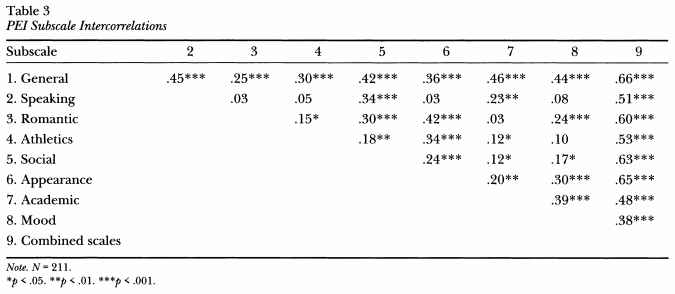
Informants who knew the subjects well also rated their confidence on each subscale, and they tended to correlate quite well with self-reported confidence, though interestingly self-confidence in one’s appearance doesn’t seem to be as readily recognizable to others as other forms of confidence.
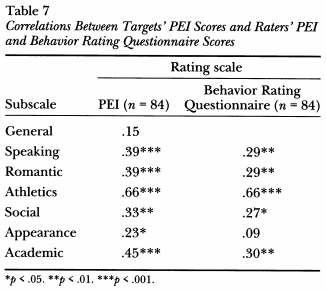
There was a correlation between the general subscale of -.6 with neuroticism, .38 with extraversion, and .21 with conscientiousness. There was also a .48 correlation with self-esteem measured by Rosenberg’s scale and .5 measured by Janis-Field’s, -.57 with anxiety and -.62 with depression, as well as some other measures of mood and optimism. For speaking confidence, of the Big Five traits extraversion had the strongest correlation at .49, followed by neuroticism at -.37 and openness at .3. It had weaker associations than the general subscale with self-esteem, anxiety, and depression. Extraversion also had the strongest correlation with romantic (.36) and social (.68) confidence.
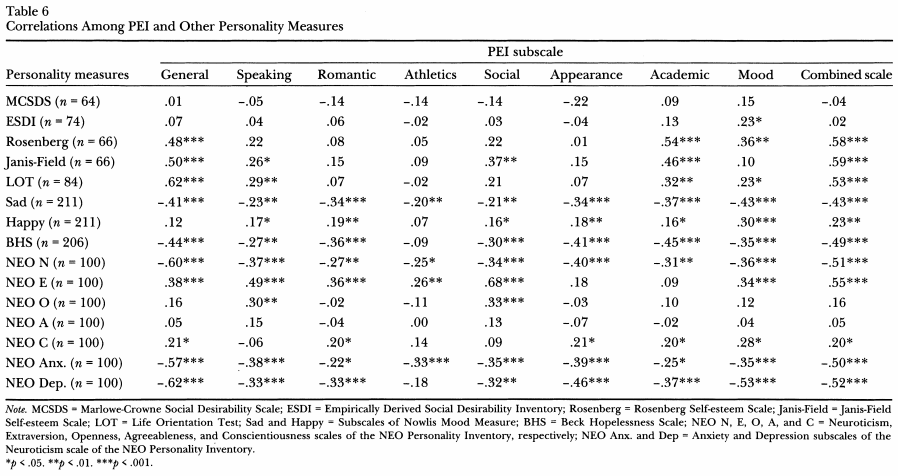
Confidence was relatively free of the influences of mood and social desirability, implying that it’s primarily driven by objective performance.
Cramer et al. (2010) found that extraversion correlated at .4 with general self-confidence and self-efficacy – a person’s belief in their ability to achieve goals. It correlated at .76 with social self-efficacy. Self-esteem correlated at .64 with general self-efficacy, .4 with social self-efficacy, and .7 with general self-confidence. Depression correlated -.35 with general self-efficacy, non-significantly with general self-confidence at -.25, and -.35 with general self-confidence.
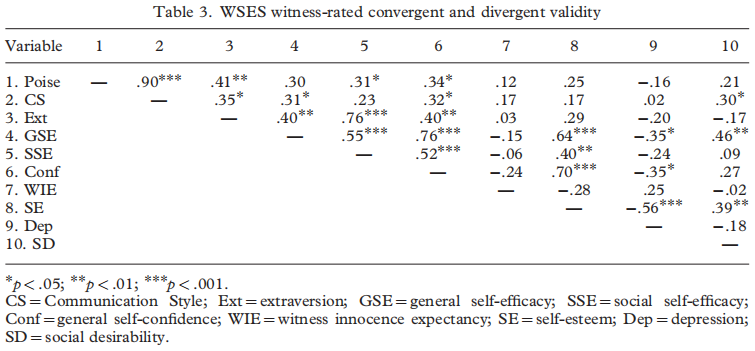
Burns et al. (2016) found among young adults that PEI correlated with neuroticism at -.69, extraversion at .33, and conscientiousness at .26. For older adults, PEI correlated with neuroticism at -.49, extraversion at .5, and agreeableness at .28. They also included TROSCI, which measures the stability of confidence over time. The results were similar here, though conscientiousness wasn’t significantly associated for young adults. The hypothesis that ‘online measures’ (which measure how confident someone in their answer to a given task) would be more closely related to ability while self-reported confidence would be more related to personality was confirmed.
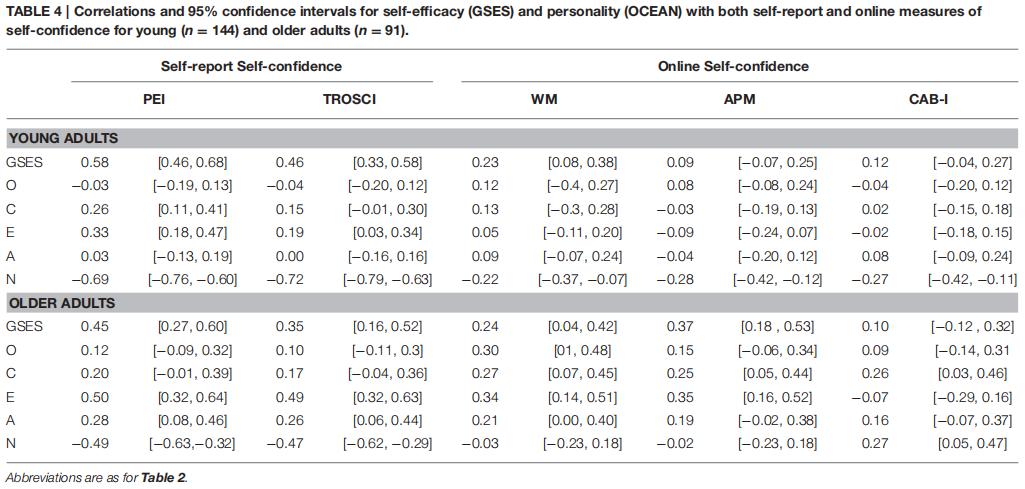
Unfortunately I couldn’t find any research which included both self-confidence and attractiveness measures, so we’ll have to rely on proxies. Overall it seems that (negative) neuroticism and extraversion are the best candidates among the Big Five. Self-esteem and social anxiety are also worth looking into.
Feingold’s Meta-analysis
To begin, let’s look at the results of Feingold’s (1992) meta-analysis. These are the associations between objectively rated physical attractiveness and the most pertinent variables: sociability & dominance (which were categorized as ‘extraversion’); general mental health (typically referring to reverse-scored neuroticism or anxiety); self-esteem (most often measured by Rosenberg’s Self-Esteem Scale); and freedom from general social anxiety (reverse-scored social anxiety & shyness).
We see a significant effect for all these variables except sociability, though the effect sizes are rather pitiful. There also weren’t any significant effects when it came to men specifically as their confidence intervals crossed zero, though the only significant sex difference was for self-esteem.
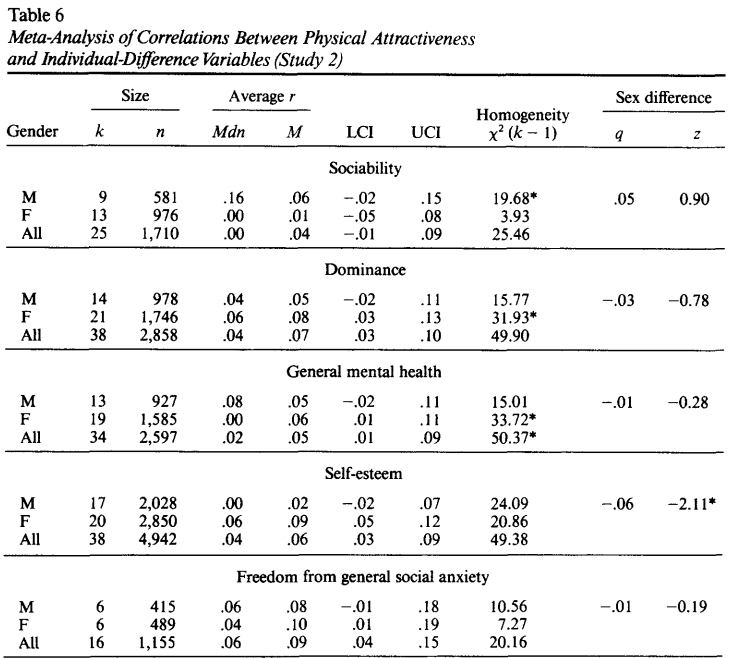
You’ll recall that in the intro I mentioned that we ought to steer clear of self-rated attractiveness. This is because as we see by comparing the previous results to the ones below, it’s to a significant degree a reflection of one’s general self-esteem rather than the other way around. It’s not hard to understand why those who have more favourable self-perceptions in general will also tend to have more favourable perceptions of their attractiveness, even if this is mostly illusory. Self-perceived attractiveness’ association with the other variables is likely in large part mediated by self-esteem as well.
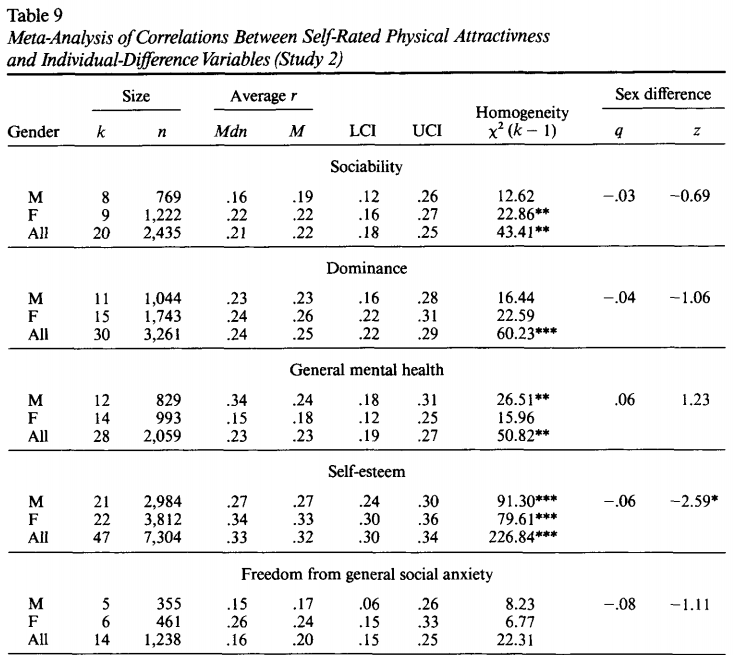
My Meta-analysis
I gathered together studies published after Feingold’s meta-analysis which included other-rated attractiveness and self-reported personality measures. I used the R package ‘MetaNSUE’ provided by Albajes-Eizagirre et al. (2019) to correct for a few non-significant results which had unreported effect sizes.
A weak association between extraversion and attractiveness of .14 was found, no effect of neuroticism was found, and a very weak association between self-esteem and attractiveness of .07 was found, similar to that yielded by Feingold’s meta-analysis.

The Q statistics weren’t significant, so there wasn’t strong evidence for heterogeneity between the studies beyond that expected by chance. However, there may have been some publication bias when it came to extraversion as a test for funnel plot asymmetry revealed a significant effect (z = 2.09, p = .036). I also looked at the Wisconsin Longitudinal Study dataset and found a .04 correlation between attractiveness and extraversion with a sample size of 4,565, which may provide some additional evidence for this, though these ratings may have limitations as they were made when the respondents were about 70 and only by a single interviewer. Also it wasn’t actually the focus of some of the smaller studies with larger effect sizes. Update: After adding another study I discovered, there was no longer significant evidence for publication bias.
Wave III of The National Longitudinal Study of Adolescent to Adult Health gave a correlation of .11 between attractiveness and assertiveness with a sample size of 1,274 among those who answered the latter question, and this facet of extraversion is likely more closely linked to confidence than the others. With a sample size of 4,860 I got one of .09 between attractiveness and responses to the question ‘You felt that you were just as good as other people, during the past seven days’. There was also a significant sex difference as observed in Feingold’s meta-analysis whereby there was a greater association for women (.13) than men (.06), maybe indicating that women’s sense of self-worth is tied more to their appearance than is men’s.
Reverse Causation?
While it’s often thought that self-enhancement is a compensatory measure taken by those low in self-esteem, it could also be that those with higher self-esteem feel more compelled to cultivate an external image which is consistent with their internal self-image. Those lower in self-esteem may be discouraged in improving their image in the fear that they won’t be able to live up to it. They may on the other hand attempt to indirectly enhance their feelings of self-worth for instance through associating with more high status people, allowing them to simultaneously maintain their negative self-image (Brown et al., 1988).
Meier et al. (2010) had 84 undergrads (45.2% male; M age = 19.6) complete a 10-item agreeableness scale regarding interpersonal concern and a 10-item extraversion scale regarding interpersonal engagement. Ten graduate students (50% male) rated them on attractiveness. Others rated how much the participants were smiling and well-groomed. Attractiveness was significantly associated with extraversion and agreeableness, as well as smiling. It was highly associated with being well-groomed. A second study was conducted among 133 undergrads (39.1% male; M age = 18.9) with raters from different states/institutions to ensure they were unacquainted, and went through the same processes. Smiling was no longer significantly associated with attractiveness, but the rest of the results remained similar.
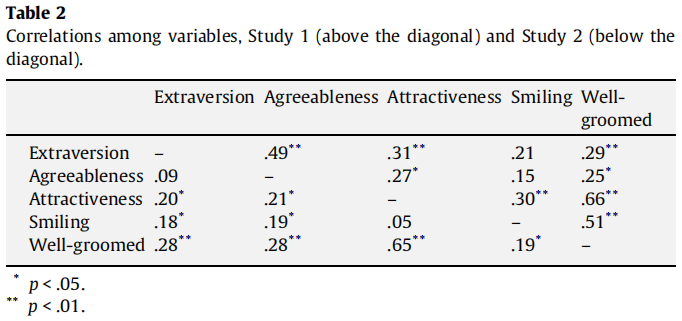
After conducting a mediation analysis, it was found that the association between attractiveness and agreeableness (β = .11, p = .20) and extraversion (β = .13, p = .13) was no longer significant. These results suggest a potential pathway mediating the association similar to that outlined in Brown et al. (1988). Consistent with this hypothesis is that more extraverted professionals report enhancing their appearance to get ahead more (Lund et al., 2007).
In a similar vein, Diener et al. (1995) found that attractiveness ratings given to photographs taken of participants with their jewelry and facial cosmetics removed and their hair hidden showed lower correlations with measures of subjective well-being and dating than ratings given to photos taken without such adjustments made.
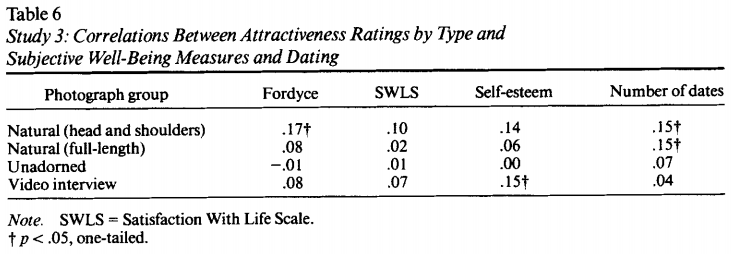
Magson et al. (2023) followed 528 students (50.1% male; M age = 11.2) from early to mid adolescence. The values highlighted in orange are self-rated attractiveness’ correlations with social anxiety, depression, and life satisfaction, and the yellow ones are for other-rated attractiveness. Consistent with Feingold’s meta-analysis, while self-rated attractiveness showed moderate associations, other-rated attractiveness showed very small and generally non-significant associations. For social anxiety, other-rated attractiveness’ correlations ranged from -.05 to -.01. For depression, -.1 to .07. For life satisfaction, .03 to .1.
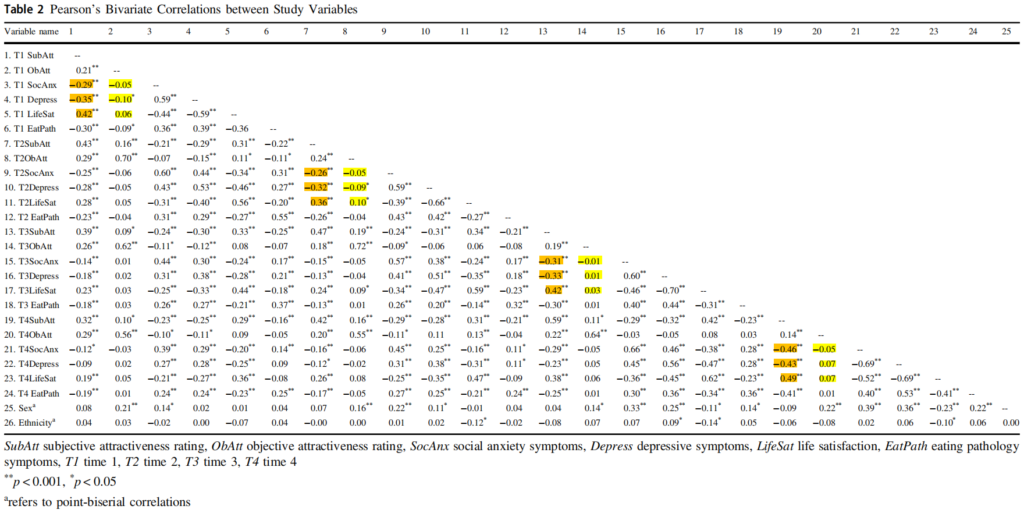
Moreover, they found that increases in internalizing symptoms actually predicted decreases in both self- and other-rated attractiveness to a greater degree than the reverse:
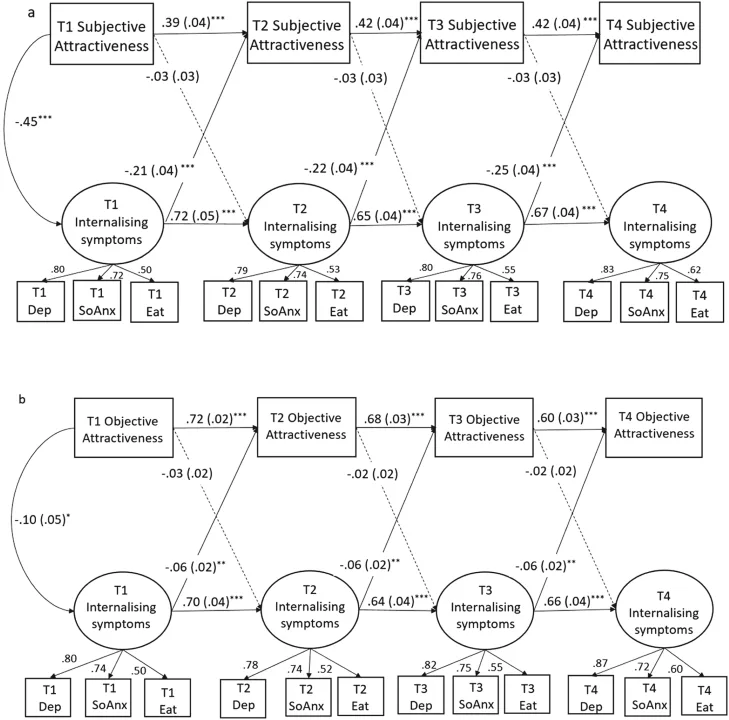
Conclusion
Most of us can probably think of enough examples of people who don’t conform to the expectations of this theory to be prepared for these underwhelming results. One such example is the Top G. His near absent chin and generally goofy face frequently the subject of mockery, that hasn’t stopped him from becoming the Johnny Bravo of our time. Even if you think it’s not a desirable form of confidence, most of us probably couldn’t pull off his persona no matter how strong our jawlines may be.

Even when it comes to the small effects which were found, it’s not clear that the causation is primarily in the assumed direction, as there is evidence for a mediating effect of grooming and a more reliable effect of internalizing symptoms on attractiveness than the reverse. People lower in self-esteem and positive affect may have less motivation and energy to maintain hygiene and grooming routines, and indulge more in unhealthy eating habits. It’s also possible that more confident people exude this in their expression or posture in ways that are perceived as attractive, and vice versa.
There are much stronger effects when it comes to self-perceived attractiveness, but this can be reasonably explained by a general positivity bias (or perhaps more so a negativity bias; Kenealy et al., 1991). In other words, it’s all in the mind.
Either people overestimate just how much more attractive people are showered with love and unattractive people are mercilessly persecuted, or this has surprisingly little effect on people’s psychology. To be fair I suppose it’s always possible that attractiveness is a double-edged sword, and while people may give you more positive attention, there may be additional expectations placed upon you which could induce stress and work to counteract the psychological benefits.
Of course none of this is to say that you can ‘just be confident bro’, either. An analysis of a twin study by Haysom et al. (2015) found similar heritability estimates for extraversion (.55 for men and .47 for women) and for facial attractiveness (.64 and .4). They also failed to detect a significant relationship between genetic variation in facial attractiveness and variation in extraversion. Heritability estimates for self-esteem of up to 73% have been reported (Caprara et al., 2009). Personality is relatively stable in adulthood (Ferguson, 2010), and Vaidya et al. (2002, 2008) found that among Big Five and affective traits, extraversion was the most stable trait over time. Part of this may be because people tend to do things which reinforce their predispositions, but there’s also likely a good deal of truth to the proverb that a leopard can’t change its spots. Whatever the case, it doesn’t appear that looks is a large barrier.
References
Tooby, J., & Cosmides, L. (1990). The past explains the present: Emotional adaptations and the structure of ancestral environments. Ethology & Sociobiology, 11(4-5), 375–424. https://doi.org/10.1016/0162-3095(90)90017-Z
Holtzman, N. S., & Strube, M. J. (2011). The intertwined evolution of narcissism and short-term mating: An emerging hypothesis. In W. K. Campbell & J. D. Miller (Eds.), The handbook of narcissism and narcissistic personality disorder: Theoretical approaches, empirical findings, and treatments (pp. 210–220). John Wiley & Sons, Inc..
Shrauger, J. S., & Schohn, M. (1995). Self-confidence in college students: Conceptualization, measurement, and behavioral implications. Assessment, 2(3), 255–278. https://doi.org/10.1177/1073191195002003006
Cramer, R. J., Neal, T. M., DeCoster, J., & Brodsky, S. L. (2010). Witness self-efficacy: development and validation of the construct. Behavioral sciences & the law, 28(6), 784–800. https://doi.org/10.1002/bsl.952
Burns, K. M., Burns, N. R., & Ward, L. (2016). Confidence-More a Personality or Ability Trait? It Depends on How It Is Measured: A Comparison of Young and Older Adults. Frontiers in psychology, 7, 518. https://doi.org/10.3389/fpsyg.2016.00518
Feingold, A. (1992). Good-looking people are not what we think. Psychological Bulletin, 111, 304-341.
Albajes-Eizagirre, A., Solanes, A., & Radua, J. (2019). Meta-analysis of non-statistically significant unreported effects. Statistical methods in medical research, 28(12), 3741–3754. https://doi.org/10.1177/0962280218811349
Leck, K. (2006). Correlates of Minimal Dating. The Journal of Social Psychology, 146(5), 549–567. https://doi.org/10.3200/SOCP.146.5.549-567
Anderson, C., John, O. P., Keltner, D., & Kring, A. M. (2001). Who attains social status? Effects of personality and physical attractiveness in social groups. Journal of personality and social psychology, 81(1), 116–132. https://doi.org/10.1037//0022-3514.81.1.116
Berry, D. S., & Miller, K. M. (2001). When boy meets girl: Attractiveness and the five-factor model in opposite-sex interactions. Journal of Research in Personality, 35(1), 62–77. https://doi.org/10.1006/jrpe.2000.2304
Meier, B. P., Robinson, M. D., Carter, M. S., & Hinsz, V. B. (2010). Are sociable people more beautiful? A zero-acquaintance analysis of agreeableness, extraversion, and attractiveness. Journal of Research in Personality, 44(2), 293–296. https://doi.org/10.1016/j.jrp.2010.02.002
Back, M. D., Schmukle, S. C., & Egloff, B. (2011). A closer look at first sight: Social relations lens model analysis of personality and interpersonal attraction at zero acquaintance. European Journal of Personality, 25(3), 225–238. https://doi.org/10.1002/per.790
Lukaszewski, A. W., & Roney, J. R. (2011). The origins of extraversion: Joint effects of facultative calibration and genetic polymorphism. Personality and Social Psychology Bulletin, 37(3), 409–421. https://doi.org/10.1177/0146167210397209
Humbad, M. N. (2012). Exploring mate preferences from an evolutionary perspective using a speed dating design. Doctoral dissertation. https://d.lib.msu.edu/etd/1485
Holtzman, N. S., & Strube, M. J. (2013). People With Dark Personalities Tend to Create a Physically Attractive Veneer. Social Psychological and Personality Science, 4(4), 461-467. https://doi.org/10.1177/1948550612461284
Lukaszewski, A. W. (2013). Testing an Adaptationist Theory of Trait Covariation: Relative Bargaining Power as a Common Calibrator of an Interpersonal Syndrome. European Journal of Personality, 27(4), 328-345. https://doi.org/10.1002/per.1908
Loehlin, J. C. (2014). Does relative bargaining power explain the general factor of personality? Personality and Individual Differences, 63, 6–9. https://doi.org/10.1016/j.paid.2014.01.024
Petrican, R., Todorov, A., & Grady, C. (2014). Personality at Face Value: Facial Appearance Predicts Self and Other Personality Judgments among Strangers and Spouses. Journal of nonverbal behavior, 38(2), 259–277. https://doi.org/10.1007/s10919-014-0175-3
Haysom, H. J., Mitchem, D. G., Lee, A. J., Wright, M. J., Martin, N. G., Keller, M. C., & Zietsch, B. P. (2015). A test of the facultative calibration/reactive heritability model of extraversion. Evolution and human behavior : official journal of the Human Behavior and Evolution Society, 36(5), 414–419. https://doi.org/10.1016/j.evolhumbehav.2015.03.002
Jauk, E., Neubauer, A. C., Mairunteregger, T., Pemp, S., Sieber, K. P., & Rauthmann, J. F. (2016). How alluring are dark personalities? The dark triad and attractiveness in speed dating. European Journal of Personality, 30(2), 125–138. https://doi.org/10.1002/per.2040
Shchebetenko, S. and Bergfeld, A.Y. (2016), The relationship between extraversion and physical attractiveness of online network users assessed by personnel recruiters. Aust J Psychol, 68: 301-311. https://doi.org/10.1111/ajpy.12108
Vesseur, E.M.H. (2017). The Effect of Narcissism on Speed-Date Success. Masters thesis. https://arno.uvt.nl/show.cgi?fid=143272
von Borell, C. J., Kordsmeyer, T. L., Gerlach, T. M., & Penke, L. (2019). An integrative study of facultative personality calibration. Evolution and Human Behavior, 40(2), 235–248. https://doi.org/10.1016/j.evolhumbehav.2019.01.002
Weber, S., Geukes, K., Leckelt, M., & Back, M. D. (2021). The attractiveness of narcissists: Hard work or natural beauty? Self and Identity, 20(2), 235–267. https://doi.org/10.1080/15298868.2019.1575899
Kito, M., Souma, T., Nishimura, T., Yamada, J., Kanemasa, Y., Taniguchi, J. and Kawamoto, T. (2023), Do Physical Attractiveness and Personality Traits Predict Romantic Partner Evaluations? A Speed-Dating Study in Japan1,2. Jpn Psychol Res. https://doi.org/10.1111/jpr.12489
Miller, J. D., Lynam, D. R., Vize, C., Crowe, M., Sleep, C., Maples-Keller, J. L., Few, L. R., & Campbell, W. K. (2018). Vulnerable Narcissism Is (Mostly) a Disorder of Neuroticism. Journal of personality, 86(2), 186–199. https://doi.org/10.1111/jopy.12303
Shackelford, T. K. (2001). Self-esteem in marriage. Personality and Individual Differences, 30(3), 371–390. https://doi.org/10.1016/S0191-8869(00)00023-4
Mares, S. H., de Leeuw, R. N., Scholte, R. H., & Engels, R. C. (2010). Facial attractiveness and self-esteem in adolescence. Journal of clinical child and adolescent psychology : the official journal for the Society of Clinical Child and Adolescent Psychology, American Psychological Association, Division 53, 39(5), 627–637. https://doi.org/10.1080/15374416.2010.501292
Visser, B. A., Pozzebon, J. A., Bogaert, A. F., & Ashton, M. C. (2010). Psychopathy, sexual behavior, and esteem: It’s different for girls. Personality and Individual Differences, 48(7), 833–838. https://doi.org/10.1016/j.paid.2010.02.008
Datta Gupta, Nabanita & Etcoff, Nancy & Jaeger, Mads. (2015). Beauty in Mind: The Effects of Physical Attractiveness on Psychological Well-Being and Distress. Journal of Happiness Studies. 17. 10.1007/s10902-015-9644-6.
Westfall, R. S., Millar, M. G., & Lovitt, A. (2019). The Influence of Physical Attractiveness on Belief in a Just World. Psychological reports, 122(2), 536–549. https://doi.org/10.1177/0033294118763172
Albajes-Eizagirre, A., Solanes, A., & Radua, J. (2019). Meta-analysis of non-statistically significant unreported effects. Statistical methods in medical research, 28(12), 3741–3754. https://doi.org/10.1177/0962280218811349
Brown, J., Collins, R.L., & Schmidt, G.W. (1988). Self-Esteem and Direct Versus Indirect Forms of Self-Enhancement. Journal of Personality and Social Psychology, 55, 445-453.
Lund, O. C. H., Tamnes, C. K., Moestue, C., Buss, D. M., & Vollrath, M. (2007). Tactics of hierarchy negotiation. Journal of Research in Personality, 41(1), 25–44. https://doi.org/10.1016/j.jrp.2006.01.002
Magson, N. R., Oar, E. L., Fardouly, J., Rapee, R. M., Freeman, J. Y. A., Richardson, C. E., & Johnco, C. J. (2023). Examining the Prospective Bidirectional Associations between Subjective and Objective Attractiveness and Adolescent Internalizing Symptoms and Life Satisfaction. Journal of youth and adolescence, 52(2), 370–392. https://doi.org/10.1007/s10964-022-01700-7
Kenealy, P., Gleeson, K., Frude, N., & Shaw, W. (1991). The importance of the individual in the “causal” relationship between attractiveness and self-esteem. Journal of Community & Applied Social Psychology, 1(1), 45–56. https://doi.org/10.1002/casp.2450010108
Caprara, G. V., Fagnani, C., Alessandri, G., Steca, P., Gigantesco, A., Cavalli Sforza, L. L., & Stazi, M. A. (2009). Human optimal functioning: the genetics of positive orientation towards self, life, and the future. Behavior genetics, 39(3), 277–284. https://doi.org/10.1007/s10519-009-9267-y
Ferguson C. J. (2010). A meta-analysis of normal and disordered personality across the life span. Journal of personality and social psychology, 98(4), 659–667. https://doi.org/10.1037/a0018770
Vaidya, J. G., Gray, E. K., Haig, J., & Watson, D. (2002). On the temporal stability of personality: evidence for differential stability and the role of life experiences. Journal of personality and social psychology, 83(6), 1469–1484.
Vaidya, J. G., Gray, E. K., Haig, J. R., Mroczek, D. K., & Watson, D. (2008). Differential stability and individual growth trajectories of big five and affective traits during young adulthood. Journal of personality, 76(2), 267–304. https://doi.org/10.1111/j.1467-6494.2007.00486.x

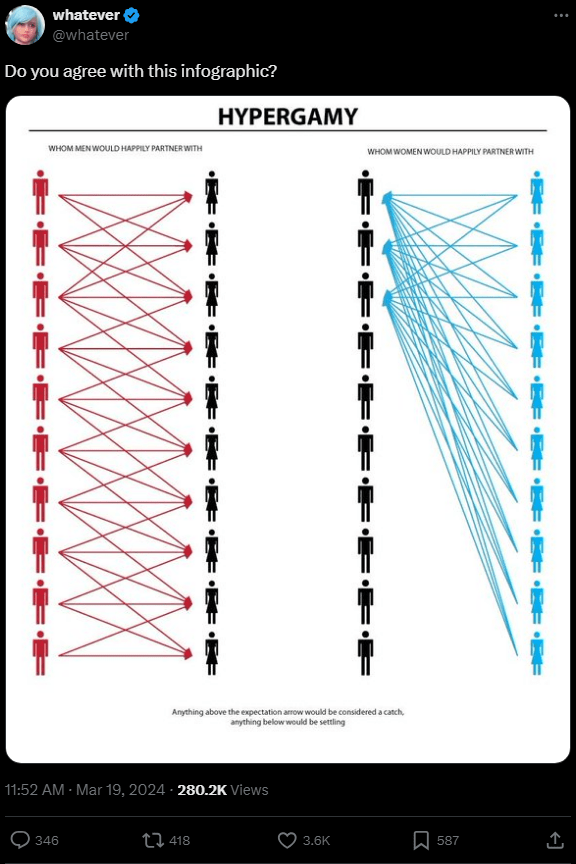
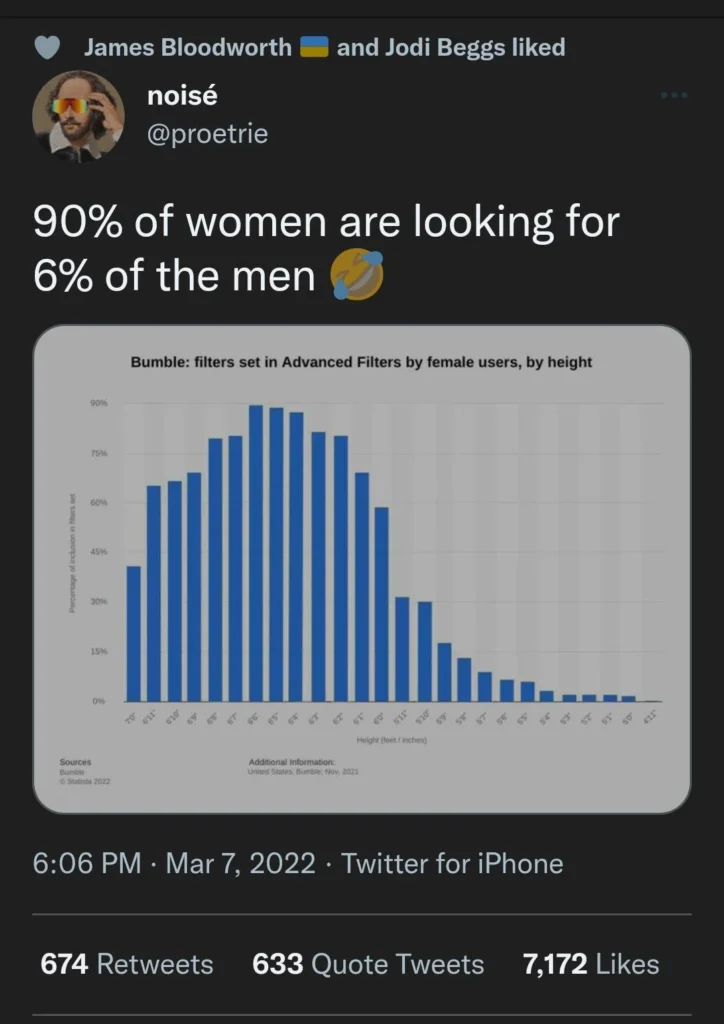
Dear anonymous Thenuancepill,
Do you believe that confidence and personality, being primarily genetic, are immutable?
I think “confidence” being genetic is a bit misleading, because people use the term differently. Extroversion and social ability most certainly have genetic components. But most of what we consider confident behavior is just behavior that is free of shame, insecurity or anxiety. And that is certainly a product of childhood conditioning, trauma, lack of acceptance and shaming, etc… Newborns aren’t born being insecure about their chin or worrying what people think about their preferences and interests lol. I think that’s something that people get wrong with confidence. You can always pretend to be “confident”, and you can also suck at pretending to be confident. That is a specific skill. But when you heal from your emotional baggage, you’re naturally gonna get over your insecurities and anxieties around people’s perceptions of you, and that goes deeper than just pretending to be confident.
Even if you look at the most extreme examples of genetic poor social ability, autistic people. There are people that are autistic but also very socially anxious, or judgmental and there’s this additional layer of emotional beliefs and shame on top of the autism. But there’s also autistic people that are very “confident”, i.e very accepting of themselves and others, they are very direct and honest and aren’t ashamed or worried how people see them.
“But most of what we consider confident behavior is just behavior that is free of shame, insecurity or anxiety. And that is certainly a product of childhood conditioning, trauma, lack of acceptance and shaming, etc… Newborns aren’t born being insecure about their chin or worrying what people think about their preferences and interests lol”
You’re right that these specific insecurities are unlikely to be genetic of course, but I think it’s highly likely that there’s a strong genetic basis for the kind of anxious/neurotic personality that would be more susceptible to developing insecurities.
But yeah confidence is one of those hard to pin down words where everyone has their own interpretation. I think what it mostly comes down to in the context of these kinds of discussions is simply a lack of social inhibition. There are of course ways to artificially lower it, but being permanently drunk or hopped up on benzos probably isn’t a great way to live either.
I loved even more than you will get done right here. The picture is nice, and your writing is stylish, but you seem to be rushing through it, and I think you should give it again soon. I’ll probably do that again and again if you protect this hike.
Attractive section of content I just stumbled upon your blog and in accession capital to assert that I get actually enjoyed account your blog posts Anyway I will be subscribing to your augment and even I achievement you access consistently fast
Wow amazing blog layout How long have you been blogging for you made blogging look easy The overall look of your web site is magnificent as well as the content
I do trust all the ideas youve presented in your post They are really convincing and will definitely work Nonetheless the posts are too short for newbies May just you please lengthen them a bit from next time Thank you for the post
I am a big fan, but I think this is oversimplified. Heterosexual women rate confidence as more important for attractiveness than heterosexual men. I speculate the effect is non-linear with diminishing returns on increased confidence.
Even if social anxiety had zero effect on attractiveness it would still make a big difference to romantic success by reducing the number of potential partners an individual meets and making them less likely to express their interest in those they do.
Population level data on the stability of personality traits does not take into account the effect of interventions. Studies show that CBT can reduce social anxiety.
Good to know I have one at least.
If you see my post on extraversion and men’s body count you’ll know I don’t deny that confidence matters and I also considered pathways unrelated to desirability like you mentioned. I think there may actually be too much focus on desirability rather than behaviour which especially matters for men given the persisting role of initiator.
The purpose of this was simply to show that there’s little relationship between it and physical attractiveness as again it’s a common talking point to say that confidence is downstream from looks. I’ve changed the title to make it more clear.
Yeah the stability may partly be down to most people not putting great effort into changing their personality. I also mentioned CBD at the end of that extraversion post as a possible ‘extraversionmaxxing’ method funnily enough, but I haven’t looked too deeply into it other than skimming a meta-analysis abstract showing a decent effect.
What i do not understood is in truth how you are not actually a lot more smartlyliked than you may be now You are very intelligent You realize therefore significantly in the case of this topic produced me individually imagine it from numerous numerous angles Its like men and women dont seem to be fascinated until it is one thing to do with Woman gaga Your own stuffs nice All the time care for it up
Your writing is so eloquent and heartfelt It’s impossible not to be moved by your words Thank you for sharing your gift with the world
The design and layout of this blog are so aesthetically pleasing and user-friendly It’s a pleasure to navigate through
Hello i think that i saw you visited my weblog so i came to Return the favore Im trying to find things to improve my web siteI suppose its ok to use some of your ideas
helloI really like your writing so a lot share we keep up a correspondence extra approximately your post on AOL I need an expert in this house to unravel my problem May be that is you Taking a look ahead to see you
What would be your next topic next week on your blog*:*,